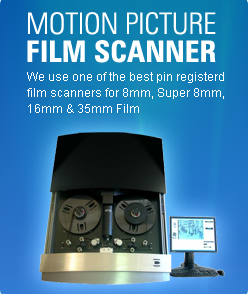
Film Conversion Equipment
Film Scanning and Film Transfer Equipment Types
The type of film scanning machine used for your 8mm, Super 8 or 16mm film conversion will have as much of an impact on the quality you receive as the resolution of the scan itself will. For example, if you wanted to digitize a photograph and tried doing it two different ways. You first put the photograph down on a table and took a picture of it using your smart phone or camera. Then you took the picture and scanned it using a flatbed scanner. If you compare the two side by side on your computer it will become really obvious that the flatbed scanner produced a digital image as good as the photograph. However, the picture you took with your phone or camera does not look close to the quality of the original photograph.
The same goes for scanning your 8mm, Super 8 or 16mm film. The real-time and frame by frame machines below are using a camcorder to take a picture of your film. The motion picture film scanner and Datacine machine are scanning the film. The results will be significantly different.
Film Conversion Equipment |
|
Real Time
|
|
Frame by Frame
|
|
Professional Film Scanners
|
|
The film transfer processes above are the basics types and do not include any restoration by themselves. Restoration comes in many different capabilities from color and exposure correction, to grain elimination, to stabilization
Gary Fun Facts: In 2006, the city celebrated its Centennial. Many notable people call Gary their original home, including well-known entertainers such as Michael Jackson and the Jackson family. Located on the shores of Lake Michigan in northwestern Indiana is the city of Gary. The largest city in Indiana's Lake County, Gary is situated only 30 miles southeast of Chicago, Illinois, and encompasses the southeastern portion of the Chicago metropolitan area.
Indiana Fun Facts: Its capital has been at Indianapolis since 1825. Indiana sits, as its motto claims, at “the crossroads of America.” It borders Lake Michigan and the state of Michigan to the north, Ohio to the east, Kentucky to the south, and Illinois to the west, making it an integral part of the American Midwest. Except for Hawaii, Indiana is the smallest state west of the Appalachian Mountains. After the American Revolution the lands of Indiana were open to U.S.








